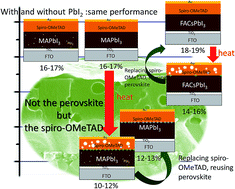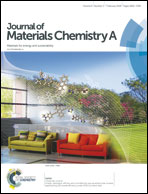Role of spiro-OMeTAD in performance deterioration of perovskite solar cells at high temperature and reuse of the perovskite films to avoid Pb-waste†
Abstract
As the long-term stability and toxicity of Pb are two profound concerns for the commercialization of Pb-based perovskite solar cells, we have undertaken this study to understand the performance degradation of perovskite solar cells at high temperature (60, 80, 100 and 120 °C) and under a humid (30–50% relative humidity) environment, and then tried to reuse the perovskite films from the degraded cells to recover the cell efficiency so as to avoid dumping of Pb-waste into the environment. As found in this study, the performance of MAPbI3 (MA = CH3NH3) cells using spiro-OMeTAD as the hole transport material (HTM) deteriorated mainly not due to the degradation of the perovskite but because of the modification of the interface between the perovskite and spiro-OMeTAD at high temperature. In addition, the spiro-OMeTAD layer underwent a severe morphological deformation at high temperature, showing large voids in it, which reduced the cell performance further. However, despite the complete reconversion of PbI2 to perovskite and the replacement of the degraded spiro-OMeTAD film with a fresh layer in the MAPbI3 cells, the cell performance was not recovered to the initial value because the modified perovskite/spiro-OMeTAD interface became worse after recycling. The thermal stability and performance recovery upon recycling were found to depend on the composition of the perovskite; faster degradation of MAPbI3 cells with a slight excess of MAI and better stability of cells not containing MA (FA0.85Cs0.15PbI3, FA = CH(NH2)2) indicated certain involvement of MA+ ions in the alteration of the perovskite/spiro-OMeTAD interface. Unlike the heat-treatment case, MAPbI3 cells, when exposed to a humid environment, degraded significantly to PbI2 and the reconversion of this PbI2 to perovskite followed by deposition of a fresh spiro-OMeTAD layer increased the cell performance but it did not recover to the initial value. This poor recovery in these cells was due to inefficient carrier transport that resulted in a lower photocurrent in the recycled devices.



 Please wait while we load your content...
Please wait while we load your content...